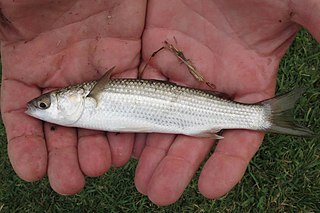
The honey badger, also known as the ratel, is a mammal widely distributed in Africa, Southwest Asia, and the Indian subcontinent. Because of its wide range and occurrence in a variety of habitats, it is listed as Least Concern on the IUCN Red List.

The Atlantic horse mackerel, also known as the European horse mackerel or common scad, is a species of jack mackerel in the family Carangidae, which includes the jacks, pompanos and trevallies. It is found in the eastern Atlantic Ocean off Europe and Africa and into the south-eastern Indian Ocean. It is an important species in commercial fisheries and is listed as a Vulnerable species on The IUCN Red List of Threatened Species.

Olea capensis, the black ironwood, is an African tree species in the olive family Oleaceae. It is widespread in sub-Saharan Africa: from the east in Somalia, Ethiopia and Sudan, south to the tip of South Africa, and west to Cameroon, Sierra Leone and the islands of the Gulf of Guinea, as well as Madagascar and the Comoros. It occurs in bush, littoral scrub and evergreen forest.

The yellowspotted catshark is a rare catshark of the family Scyliorhinidae. It is found in the southeast Atlantic, from Lüderitz, Namibia to central Natal, South Africa, between latitudes 0° and 37° S. It can grow up to a length of about 1.22 metres. The reproduction of this catshark is oviparous.

The African clawless otter, also known as the Cape clawless otter or groot otter, is the second-largest freshwater otter species. It inhabits permanent water bodies in savannah and lowland forest areas through most of sub-Saharan Africa. It is characterised by partly webbed and clawless feet, from which their name is derived. The word 'aonyx' means clawless, derived from the prefix a- ("without") and onyx ("claw/hoof").
The dark-brown serotine is a species of vesper bat found in Central and West Africa.

The forest shrew is a species of shrew in the mouse shrew family, Soricidae. It is found in Lesotho, South Africa, and Eswatini. Its natural habitats include temperate forests, dry savanna, Mediterranean-type shrubby vegetation, and temperate grassland. The term "forest shrews" in the plural is sometimes confusingly used to collectively refer to a different genus, Sylvisorex.

The freshwater mullet is a species of fish in the family Mugilidae. It is endemic to South Africa.

The European anchovy is a forage fish somewhat related to the herring. It is a type of anchovy; anchovies are placed in the family Engraulidae. It lives off the coasts of Europe and Africa, including in the Mediterranean Sea, the Black Sea, and the Sea of Azov. It is fished by humans throughout much of its range.

An anchovy is a small, common forage fish of the family Engraulidae. Most species are found in marine waters, but several will enter brackish water, and some in South America are restricted to fresh water.

Cynoglossus capensis, commonly known as the sand tonguesole is a species of tonguefish.

Champsodon is the sole genus in the family Champsodontidae. These fishes, the crocodile toothfishes, are native to the Indo-Pacific region.

The onefin electric ray or Cape numbfish is a common but little-known species of electric ray in the family Narkidae, native to South Africa and Namibia. It is a benthic fish found in shallow coastal bays over sandy or muddy bottoms. This small species reaches 38 cm (15 in) in length, and has a nearly circular pectoral fin disc and a short, muscular tail that supports a large caudal fin. It can be identified by its single dorsal fin, which is located over the large pelvic fins. Its dorsal coloration is yellowish to dusky brown.

Terapon theraps, the largescaled terapon, banded grunter, banded trumpeter, flagtail grunter, flagtail trumpeter, large-scaled grunter-perch, Northern grunter and spiky trumpeter, is a species of marine ray-finned fish, a grunter from the family Terapontidae. This species has a wide distribution in the Indo-Pacific region.

Pachymetopon blochii, the hottentot seabream or hottentot, is a species of sea bream in the family Sparidae, native to the southwestern coast of Africa.

The Tstsikamma Marine Protected Area is a marine protected area on the south coast of South Africa, in both the Western Cape and Eastern Cape. It is on the coast of the Tsitsikamma National Park, and is one of the oldest MPAs in the country. The MPA provides protection for marine habitat and wildlife, including birds and threatened and endangered fish species.

Champsodon nudivittis, also known as the nakedband gaper, is a species of marine ray-finned fish, a crocodile toothfish belonging to the family Champsodontidae. It occurs in the Indo-West Pacific from Madagascar, Indonesia, the Philippines and Australia. It was recorded in 2008 in Iskenderun Bay on the Mediterranean coast of Turkey, likely introduced by ballast water. It is now commonly found from Greece to Israel in the eastern Mediterranean Sea.
Champsodon vorax, also known as the greedy gaper, is a species of marine ray-finned fish, a crocodile toothfish belonging to the family Champsodontidae. It occurs in the Indo-West Pacific from Maldives, Australia, Vietnam, Philippines, Indonesia and Guam. It has also been recorded in the Mediterranean Sea off the coast of Lebanon.
















